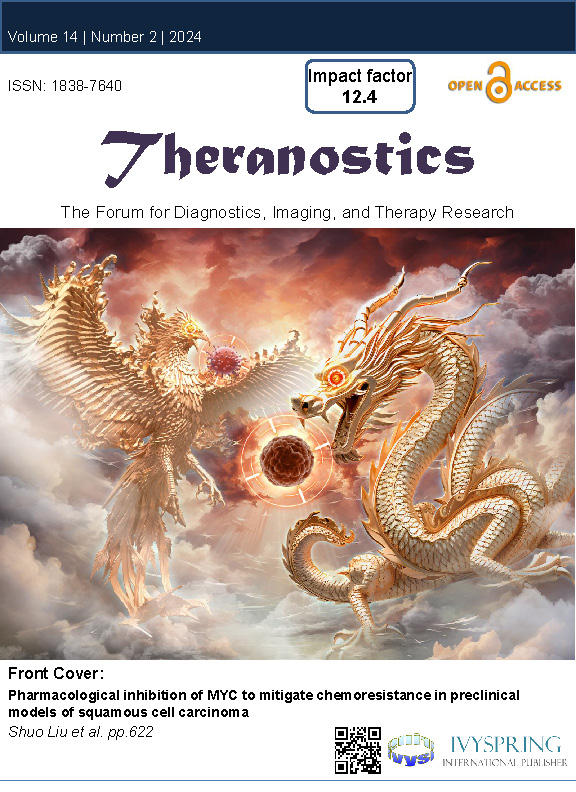Dual-purposing disulfiram for enhanced chemotherapy and afterglow imaging using chlorin e6 and semiconducting polymer combined strategy
IF 12.4
1区 医学
Q1 MEDICINE, RESEARCH & EXPERIMENTAL
引用次数: 0
Abstract
Rationale: One of the main challenges in chemotherapy is achieving high treatment efficacy while minimizing adverse events. Fully exploiting the therapeutic potential of an old drug and monitoring its effects in vivo is highly valuable, but often difficult to achieve./nMethods: In this study, by encapsulating disulfiram (DSF) approved by US Food and Drug Administration, semiconducting polymer nanocomplex (MEHPPV), and Chlorin e6 into a polymeric matrix F127 via nanoprecipitation method, a nanosystem (FCMC) was developed for afterglow imaging guided cancer treatment. The characteristics, stability as well as the ability of singlet oxygen (1O2) production of FCMC were first carefully examined. Then, we studied the mechanism for enhanced anti-cancer efficiency and afterglow luminescence in vitro. For experiments in vivo, 4T1 subcutaneous xenograft tumor mice were injected with FCMC via the tail vein every three days and the antitumor effect of FCMC was evaluated by monitoring tumor volume and body weight every three day./nResults: The nanosystem, which combines DSF with Ce6, can generates abundant 1O2 that enhances the antitumor activity of DSF. The in vivo results show that FCMC-treated group exhibits an obviously higher tumor-growth inhibition rate of 67.89% after 15 days of treatment, compared to the control group of F127@MEHPPV-CuET. Moreover, Ce6 also greatly enhances the afterglow luminescence intensity of MEHPPV and promotes the redshift of the afterglow emission towards the ideal near-infrared imaging window, thereby enabling efficient afterglow tumor imaging in vivo./nConclusions: This multifunctional nanoplatform not only improves the anticancer efficacy of DSF, but also enables monitoring tumor via robust afterglow imaging, thus exhibiting great potential for cancer therapy and early therapeutic outcome prediction.采用氯素 e6 和半导体聚合物组合策略,将双硫仑用于增强化疗和余辉成像的双重用途
理由化疗的主要挑战之一是在实现高疗效的同时尽量减少不良反应。充分挖掘旧药的治疗潜力并监测其体内疗效非常有价值,但往往难以实现:本研究通过纳米沉淀法将美国食品药品管理局批准的双硫仑(DSF)、半导体聚合物纳米复合物(MEHPPV)和氯霉素 e6封装到聚合物基质 F127 中,开发了一种用于余辉成像引导癌症治疗的纳米系统(FCMC)。我们首先仔细研究了 FCMC 的特性、稳定性以及产生单线态氧(1O2)的能力。然后,我们研究了体外提高抗癌效率和余辉发光的机制。在体内实验中,4T1 皮下异种移植肿瘤小鼠每三天经尾静脉注射一次 FCMC,并通过监测肿瘤体积和体重来评估 FCMC 的抗肿瘤效果:DSF与Ce6结合的纳米系统能产生丰富的1O2,从而增强DSF的抗肿瘤活性。体内实验结果表明,与 F127@MEHPPV-CuET 对照组相比,FCMC 治疗组在治疗 15 天后的肿瘤生长抑制率明显提高,达到 67.89%。此外,Ce6 还大大增强了 MEHPPV 的余辉发光强度,并促进余辉发射向理想的近红外成像窗口重移,从而实现了体内高效的肿瘤余辉成像:这种多功能纳米平台不仅提高了 DSF 的抗癌效果,还能通过强余辉成像监测肿瘤,因此在癌症治疗和早期疗效预测方面具有巨大潜力。
本文章由计算机程序翻译,如有差异,请以英文原文为准。
求助全文
约1分钟内获得全文
求助全文
来源期刊

Theranostics
MEDICINE, RESEARCH & EXPERIMENTAL-
CiteScore
25.40
自引率
1.60%
发文量
433
审稿时长
1 months
期刊介绍:
Theranostics serves as a pivotal platform for the exchange of clinical and scientific insights within the diagnostic and therapeutic molecular and nanomedicine community, along with allied professions engaged in integrating molecular imaging and therapy. As a multidisciplinary journal, Theranostics showcases innovative research articles spanning fields such as in vitro diagnostics and prognostics, in vivo molecular imaging, molecular therapeutics, image-guided therapy, biosensor technology, nanobiosensors, bioelectronics, system biology, translational medicine, point-of-care applications, and personalized medicine. Encouraging a broad spectrum of biomedical research with potential theranostic applications, the journal rigorously peer-reviews primary research, alongside publishing reviews, news, and commentary that aim to bridge the gap between the laboratory, clinic, and biotechnology industries.
 求助内容:
求助内容: 应助结果提醒方式:
应助结果提醒方式:


